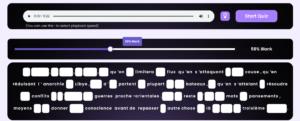Three moments in learning three languages stand out for me, even years on.
First, I was in high school. Each year my family would go to Ensenada or Tijuana to build with Homes of Hope for a family who lived in a lean-to shack. And each year my family would ask me: “What did they just say? You take Spanish, you should know!” And then, there I was. I couldn’t even understand the children, let alone their parents.
And again, years later, I was in a minivan riding from the Beijing Capital Airport to my host family’s house. The sweat slowly beading on my brow. I couldn’t understand a single question my host mom asked from the front seat. She began to shout at me in the backseat. I’m sure my face showed confusion and terror, at least that’s how I felt inside. Two years of Chinese lessons in a university setting for nothing!
And any time I traveled in France, getting asked directions, a simple question on the train, or a question from a person in a store. I struggled to piece together what was said through unfamiliar liaisons and accents. This, despite my long streak on gamified language apps and a few months of class.
Why couldn’t I understand?
The Disconnect.
All the teachers I’ve spoken with have said the same thing: There are some students who grasp vocab, grammar rules, and the essence of the language, those same students complain about not understanding when out in the real world (radio, podcasts, movies, TV, language meetups).
I’m one of those.
This disconnect is a major pitfall for learners. It also inspired my own adventure to fluency in French. It’s why I created this project. French in the wild is wildly different from the French your teacher uses in class.
To make this real, simply consider these two podcast clips on this site:
This clip from the Manger podcast, Simon introduces his love for cereals,
Manger is created for French listeners and Simon speaks like a normal young French guy, someone you might hear at the corner cafe during happy hour on a Thursday evening
And this clip from Inner French is created by a French teacher, for his French students. The accent is clear, there is repetition (as I’m sure your teacher does in class).
Don’t get me wrong, I love all my language teachers.
My French teacher is great. I can understand everything she says. In fact, I can say the same thing about my Chinese professors in college, and my Spanish teachers in high school.
Not only have language teachers always been patient with my slow pace, my disjointed word order, and, of course, my grammatically incorrect sentences, they also speak in a way that is clear, slow paced, and repetitive.
For better or for worse, language teachers can make me feel like an expert.
And that is great for my confidence. Confidence is essential when getting new students to open their mouths and try speaking a foreign language. And because of this, I happily open my mouth to speak in class.
And then it’s outside of class, especially when my two ears are involved, where things fall apart.
My confidence doesn’t matter. French in real life is nothing like French in the classroom.

It all comes down to three things
After years of learning different languages, I found that three areas to focus on help unlock real world speech and let you move beyond your teacher’s speaking: pace, accents, and filler words.

The pace of French is different.
I’m sure your teacher speaks at most a leisurely 160 words per minute, similar to English. While French in the wild, real life French, is well over 200 words per minute. Curious just how much faster native French speakers talk? I break it down in this post.
And the two clips above demonstrate just that. Inner French is less than 160 wpm, he’s a teacher, and he speaks at a pace I’m sure you’re familiar with in any classroom setting. It’s easy to follow. He repeats phrases and speaks in vocab that is accessible.
Teachers know their audience and they’ll adjust their speaking to suit. My teacher now says this is her pace naturally with friends. I believe it’s possible, but there are still other ways that a teacher will adjust their speaking for students. They’ll repeat and adjust word choice for their audience.
This is an important distinction to make. In real life, in French in the wild, questions come so much faster than they ever do in class. They aren’t repeated or rephrased for understanding.
While French people are patient with my slow French, their pace in response typically remains fast. It’s just the normal way of speaking.

The accents are different
Accents throughout France are different. And French speakers outside of France have different accents still. Throw all these different ways of speaking together in a city like Paris, Nice, or Marseille and it can easily overwhelm. This isn’t the French you learned in class.
These are all the accents we hear out and about in the real world. I have no idea who is speaking with a Brittany accent, or a Calais accent, or a Southwest accent. But I know that there are some that sound clearer to me than others.
The more exposure I can get to varying accents, the better it is for our ear and understanding. But often speaking, especially in French and Chinese education, there are very specific “correct” ways of pronunciation and speaking. China uses a Beijing accent as “official” and anyone appearing on TV for the national channels must pass rigorous exams to ensure they speak clearly. Speaking French is regulated by the Academy in Paris, to ensure the “appropriate” speech.
But language in the real world is seldom that regulated. And while our teachers might focus on “good” accents to make sure we speak clearly, our ears need a wide range of accents to tune.
When I first lived in Beijing, a good friend of mine was from Guizhou. Guizhou is generally a pretty rural place in China. He had grown up in Chongqing, another place known for its regional dialect. When we’d be at a restaurant together, I would have to translate for him. The server might not understand. It was only through spending so much time with him that I could comprehend a wider range of Chinese than even native speakers in Beijing. That is already light years from the Chinese my professor taught in college.
Simon’s speech in the second clip above highlights that varied accent. While still male and baritone like Hugo in the first clip, there is a varied timbre. Take a listen, can you hear the same words showing up different from your teacher?

Ums and filler words.
As in English, there are natural ways of speaking, likes, ums, and uhs sneak their way into most speech. And the French use their own filler words.
I had a teacher at AF in Taipei who absolutely hated filler words. He would shudder even talking about “quoi” and other filler words. It was only when a listening exercise used a “quoi” that he was forced to talk about these words. From the way he described it, it was clear that he would have preferred not to teach it at all.
But that doesn’t serve the student in real life. Language happens with filler words and additions by the speaker.
I have shared this story elsewhere on the site (about page), but it is worth repeating here. When I lived in the hutongs of Beijing, hot July nights would see me joining my neighbors, trying to be a part of the community and practicing my French. In the circle, with a cold beer in hand, there were some neighbors I could understand without issue. And others that were almost intelligible. They had varying Beijing accents, and the accent I knew. I couldn’t figure out why some people were almost impossible to understand.
It was when I realized that this one guy was dropping F bombs every third word that it finally hit me. It was like flipping a switch, it was an unlock that suddenly his speech was clear.
Teachers often won’t happily teach vulgar terms in class. But in some dialects and in some places, they show up. Once you understand these words, they can serve as an unlock that makes unintelligible speech suddenly clear.

The only way to get there is to immerse.
I mean this sincerely: there is absolutely nothing wrong with your teacher.
They help me grasp cultural nuance and grammar rules. Two things that most normal people simply don’t have the patience to describe clearly in the real world.
But I was seeking structure outside of class. Podcasts offer that structure. They are a wonderful way to break into French in real life and hear it as it exists in the wild.
Immersion in French anywhere is possible by working with projects like mine. Or by creating moments of immersion throughout the day.
While most learners will go after podcasts created by teachers for students, I highly recommend taking on podcasts meant for native speakers. Here are some podcasts to consider as you’re starting your journey. These will provide true French in real life and augment the lessons you receive from your teachers.
Have you found your French learning journey similar to mine?








